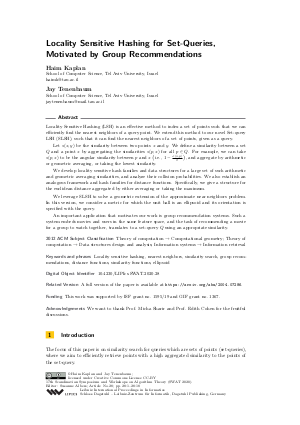@InProceedings{kaplan_et_al:LIPIcs.SWAT.2020.28,
author = {Kaplan, Haim and Tenenbaum, Jay},
title = {{Locality Sensitive Hashing for Set-Queries, Motivated by Group Recommendations}},
booktitle = {17th Scandinavian Symposium and Workshops on Algorithm Theory (SWAT 2020)},
pages = {28:1--28:18},
series = {Leibniz International Proceedings in Informatics (LIPIcs)},
ISBN = {978-3-95977-150-4},
ISSN = {1868-8969},
year = {2020},
volume = {162},
editor = {Albers, Susanne},
publisher = {Schloss Dagstuhl -- Leibniz-Zentrum f{\"u}r Informatik},
address = {Dagstuhl, Germany},
URL = {https://drops-dev.dagstuhl.de/entities/document/10.4230/LIPIcs.SWAT.2020.28},
URN = {urn:nbn:de:0030-drops-122756},
doi = {10.4230/LIPIcs.SWAT.2020.28},
annote = {Keywords: Locality sensitive hashing, nearest neighbors, similarity search, group recommendations, distance functions, similarity functions, ellipsoid}
}

 Creative Commons Attribution 3.0 Unported license
Creative Commons Attribution 3.0 Unported license
